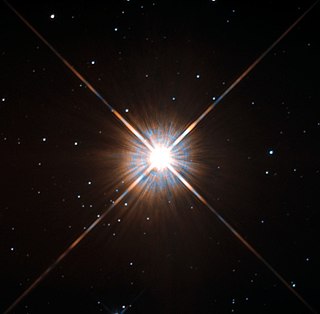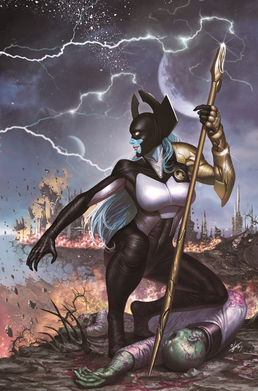
Alpha Centauri is a triple star system in the southern constellation of Centaurus. It consists of three stars: Rigil Kentaurus, Toliman (B) and Proxima Centauri (C). Proxima Centauri is the closest star to the Sun at 4.2465 light-years.

Proxima Centauri is a small, low-mass star located 4.2465 light-years (1.3020 pc) away from the Sun in the southern constellation of Centaurus. Its Latin name means the 'nearest [star] of Centaurus'. It was discovered in 1915 by Robert Innes and is the nearest-known star to the Sun. With a quiescent apparent magnitude of 11.13, it is too faint to be seen with the unaided eye. Proxima Centauri is a member of the Alpha Centauri star system, being identified as component Alpha Centauri C, and is 2.18° to the southwest of the Alpha Centauri AB pair. It is currently 12,950 AU (0.2 ly) from AB, which it orbits with a period of about 550,000 years.

Pangaea Proxima is a possible future supercontinent configuration. Consistent with the supercontinent cycle, Pangaea Proxima could form within the next 250 million years. This potential configuration, hypothesized by Christopher Scotese in November 1982, earned its name from its similarity to the previous Pangaea supercontinent. Scotese later changed Pangaea Ultima to Pangaea Proxima to alleviate confusion about the name Pangaea Ultima which could imply that it would be the last supercontinent. The concept was suggested by extrapolating past cycles of formation and breakup of supercontinents, not on theoretical understanding of the mechanisms of tectonic change, which are too imprecise to make predictions that far into the future. "It's all pretty much fantasy to start with," Scotese has said. "But it's a fun exercise to think about what might happen. And you can only do it if you have a really clear idea of why things happen in the first place."
"Rautavaara's Case" is a science fiction short story by American writer Philip K. Dick. It was first published in 1980 in Omni magazine and subsequently in the 1985 short story collection I Hope I Shall Arrive Soon. The story was also included on We Can Remember It For You Wholesale, volume five of the Collected Short Stories of Philip K. Dick in 2003.

Próxima Estación: Esperanza is the second solo album by Manu Chao. The album was released in Europe in 2001. It was released in the United States on 5 June 2001 on Virgin Records.

The European white egg, bearded amanita or European egg amidella, is a species of fungus of the genus Amanita in the family Amanitaceae. It is a large, white-colored fungus, often tinged with cream. Native to Europe, it is found on plains as well as mountains in the Mediterranean region. The species was first described in 1833 by Pierre Bulliard, a French physician and botanist, and Lucien Quélet, a French mycologist and naturalist.
Proxima may refer to one of the following:
Leptophoca is an extinct genus of earless seals from the North Atlantic realm.

A sub-Earth is a planet "substantially less massive" than Earth and Venus. In the Solar System, this category includes Mercury and Mars. Sub-Earth exoplanets are among the most difficult type to detect because their small sizes and masses produce the weakest signal. Despite the difficulty, one of the first exoplanets found was a sub-Earth around a millisecond pulsar PSR B1257+12. The smallest known is WD 1145+017 b with a size of 0.15 Earth radii, or somewhat smaller than Pluto. However, WD 1145+017 b is not massive enough to qualify as a sub-Earth classical planet and is instead defined as a minor, or dwarf, planet. It is orbiting within a thick cloud of dust and gas as chunks of itself continually break off to then spiral in towards the star, and within around 5,000 years it will have more-or-less disintegrated.
A Próxima Vítima is a Brazilian telenovela that was produced and aired by TV Globo from March 13, 1995, to November 3, 1995, totaling 203 chapters.

Proxima Midnight is a fictional supervillain appearing in American comic books published by Marvel Comics. She is a prominent member of the Black Order, a team of aliens who work for Thanos. Created by writer Jonathan Hickman, she first appeared in New Avengers #8.

Pterolophia is a genus of longhorn beetles of the subfamily Lamiinae, containing the following species:

The Black Order is a supervillain team appearing in American comic books published by Marvel Comics. They are a group of alien warriors with various supernatural abilities who serve Thanos. The original iteration, introduced in the 2013 Infinity storyline following a cameo appearance in The New Avengers #8, consists of Ebony Maw, Corvus Glaive, Proxima Midnight, Black Dwarf, and Supergiant, with Black Swan later joining the group as well.
A Próxima Atração is a Brazilian telenovela produced and broadcast by TV Globo. It premiered on 26 October 1970 and ended on 17 April 1971, with a total of 150 episodes. It's the seventh "novela das sete" to be aired at the timeslot. It is created by Vicente Sesso and directed by Régis Cardoso.

Proxima Centauri b, sometimes referred to as Alpha Centauri Cb, is an exoplanet orbiting within the habitable zone of the red dwarf star Proxima Centauri, which is the closest star to the Sun and part of the larger triple star system Alpha Centauri. It is about 4.2 ly (1.3 pc) from Earth in the constellation Centaurus, making it, along with the currently-disputed Proxima c, and Proxima d the closest known exoplanets to the Solar System.

Amanita proxima is a species of Amanita from France, Italy, and Spain. It is poisonous.

Proxima Centauri c is a controversial exoplanet candidate claimed to be orbiting the red dwarf star Proxima Centauri, which is the closest star to the Sun and part of a triple star system. It is located approximately 4.2 light-years from Earth in the constellation of Centaurus, making it, Proxima b, and Proxima d the closest known exoplanets to the Solar System.

BLC1 was a candidate SETI radio signal detected and observed during April and May 2019, and first reported on 18 December 2020, spatially coincident with the direction of the Solar System's closest star, Proxima Centauri.

Proxima Centauri d is an exoplanet orbiting the red dwarf star Proxima Centauri, the closest star to the Sun and part of the Alpha Centauri triple star system. Together with two other planets in the Proxima Centauri system, it is the closest known exoplanet to the Solar System, located approximately 4.2 light-years away in the constellation of Centaurus. The first signs of the exoplanet emerged as a weak 5.15-day signal in radial velocity data taken from the Very Large Telescope during a 2020 study on Proxima b's mass. This signal was formally proposed to be a candidate exoplanet by Faria et al. in a follow-up paper published in February 2022.













